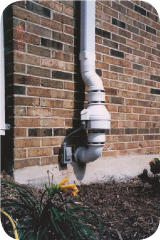Sporlan Valve Plant #1 Superfund Site, Washington, Franklin County, Missouri - Fact Sheet, July 2019
EPA Announces Placement of Site on National Priorities List and July 16 Public Meeting
INTRODUCTION
The Sporlan Valve Plant #1 Superfund Site (site) in Washington, Missouri, has been added to the federal Superfund National Priorities List (NPL). The NPL is a list of the nation’s hazardous waste sites with the highest priority for cleanup. The U.S. Environmental Protection Agency (EPA) Region 7 is hosting a Public Meeting to provide a site update, information about next steps, and technical assistance resources. Following presentations, EPA and state agency representatives will be available to discuss the site.
The meeting will be held:
6:30 to 8:30 p.m.
Knights of Columbus #1121
1121 Columbus Lane
Washington, MO 63090
SITE BACKGROUND
The site is located at 611 E. 7th Street, Washington, Franklin County, Missouri. The site was first developed as a refrigeration valve manufacturing facility in 1939. Trichloroethylene (TCE) was used at the facility as a degreaser and industrial solvent. Releases of TCE have occurred, potentially over several decades, resulting in contaminated soil and groundwater beneath the facility.
ABOUT TCE
TCE has been detected in groundwater, soil gas, and indoor air surrounding the site. TCE is the primary contaminant of concern at the site. Exposure to TCE poses potential human health hazards to the central nervous system, kidney, liver, immune system, male reproductive system, and developing fetus.
TCE is characterized by EPA as “carcinogenic in humans” by all routes of exposure. Other contaminants of concern at this site include vinyl chloride and dichloroethene, both of which are breakdown byproducts of the degradation of TCE.
SUPERFUND PROGRAM
-
Removal actions address immediate threats to human health and the environment posed by contamination.
- Remedial actions address sites that require extensive and potentially long-term cleanup.
VAPOR INTRUSION
The primary exposure pathway of concern at this site is vapor intrusion (VI). VI is a process by which volatile chemicals in soil and groundwater can migrate into and accumulate inside buildings.
A series of actions have been taken to address the threat of VI related to the site. These actions have included sampling for TCE in homes, installing, and requiring the potentially responsible party to install vapor mitigation systems, like the one shown in Figure 1.
Vapor mitigation systems can be installed to reduce health risks in buildings where chemical vapors from contaminated soil and groundwater may be inhaled by indoor occupants. At this time, several systems have been installed at homes near the site.
FUTURE SITE ACTIONS
The NPL listing for the site was effective on June 14, 2019. Listing of this site makes it eligible for response action money authorized by Congress under the Comprehensive Environmental Response, Compensation and Liability Act (CERCLA), commonly known as the Superfund law. If a responsible party is not identified, a site cannot undergo a remedial cleanup unless it is listed on the NPL.
Now that the site is listed on the NPL, a Remedial Investigation (RI) will be performed to fully define the nature and extent of contamination. The RI will include additional sampling at the site and an evaluation of risk to human health and the environment. Following the RI, a Feasibility Study (FS) will be prepared. The FS includes evaluations of technologies capable of treating the contamination. It also includes an assessment of the cost and performance of technologies that could be used to clean up the site. EPA will work to inform the community about site progress throughout all phases of the cleanup.
TECHNICAL ASSISTANCE GRANT
Inclusion of the site on the NPL guarantees the public an opportunity to participate in cleanup decisions. EPA wants to help affected communities understand the technical information related to a site. EPA's Technical Assistance Grant program provides up to $50,000 for a qualified citizens group to hire independent technical advisors. Advisors can help citizens interpret technical data, understand site hazards, and become more knowledgeable about the different technologies used to clean up sites.
For additional information about technical assistance resources, contact EPA.
ADDITIONAL RESOURCES
The Administrative Records for the removal actions conducted at this site are available online (under Site Documents & Data).
For vapor intrusion (VI) information, visit EPA’s website.
Technical Assistance Grant information, and additional information about EPA’s Superfund program are available at www.epa.gov/mo/missouri-cleanups and www.epa.gov/superfund.
More information about the Superfund process can be found online.
EPA CONTACT INFORMATION
If you have questions about this Fact Sheet and would like to receive site updates, and/or need additional information, please contact EPA:
Community Engagement Specialist
U.S. EPA Region 7
Lenexa, KS 66219
Email: kramer.elizabeth@epa.gov
REASONABLE ACCOMODATIONS
EPA is committed to providing reasonable accommodations to individuals with disabilities. For reasonable accommodations at the Public Meeting, please contact Jonathan Cooper by email at: cooper.jonathan@epa.gov. Speech- or hearing-impaired individuals should email or call using the local relay service.

